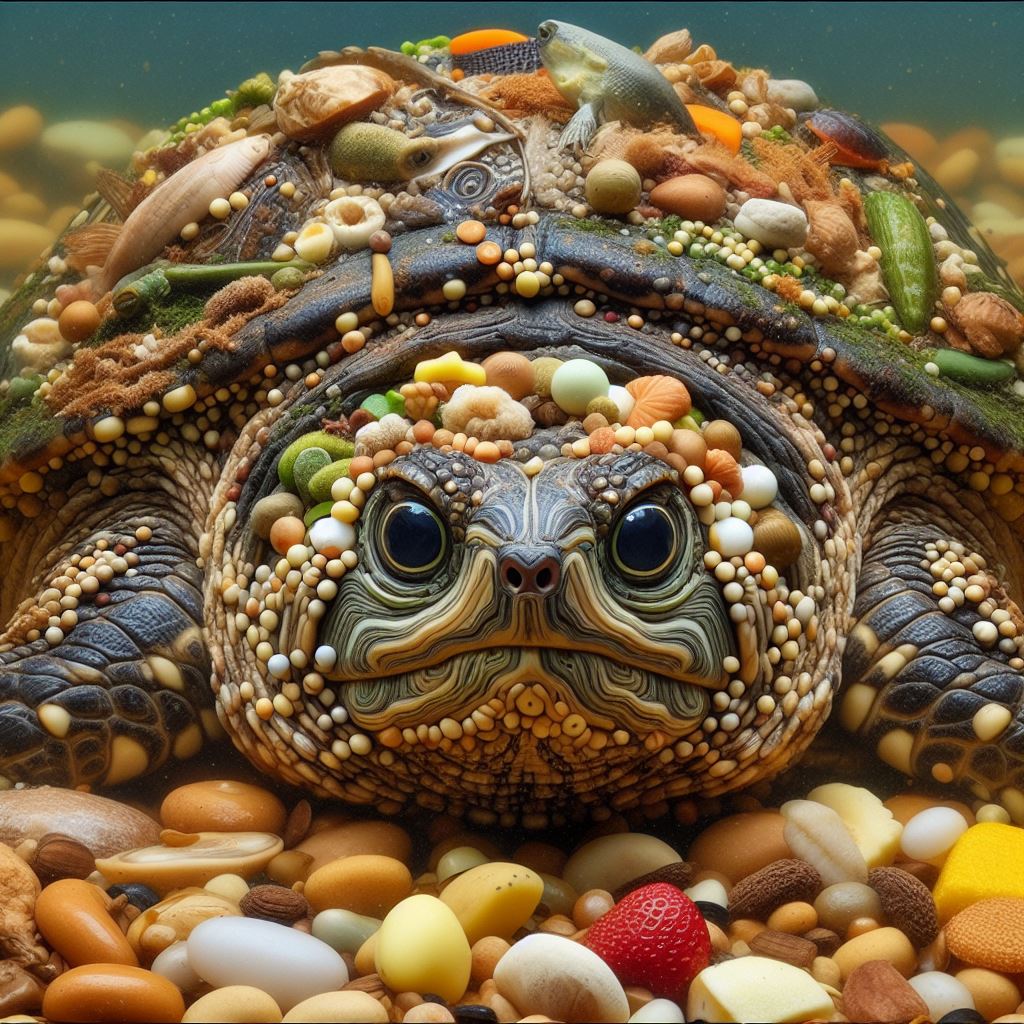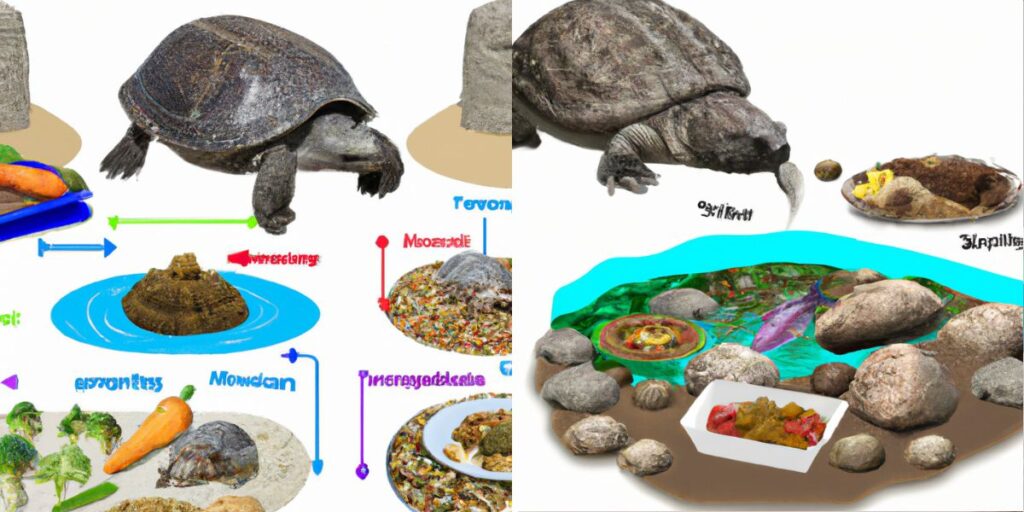Snapping turtles are known for their diverse diet, and this remains true even when they are placed in captivity. They are opportunistic feeders and will consume a wide range of prey. However, it is crucial for their health and well-being to ensure they are provided with a balanced and varied diet. This article will outline the key components of a snapping turtle’s diet in captivity, the potential risks associated with feeding, and the best practices for ensuring their nutritional needs are met.
Key Takeaways:
- Snapping turtles in captivity primarily feed on: fish, earthworms, insects, and vegetation. These make up the majority of their diet and provide essential nutrients for their health and longevity.
- It is important to provide a balanced diet: Snapping turtles need a well-rounded diet to thrive in captivity, including a mix of protein, vegetables, and calcium sources. This helps to ensure they receive all necessary nutrients for growth and overall well-being.
- Feeding frequency: Typically, adult snapping turtles should be fed every 2-3 days, while younger turtles may require daily feedings. It’s important to monitor their eating habits and adjust feeding schedules accordingly to maintain their health.
Natural Diet of Snapping Turtles
Clearly, understanding the natural diet of snapping turtles is essential when creating a suitable feeding plan for these reptiles in captivity. Snapping turtles are omnivores, meaning they have a varied diet that includes both animal and plant matter. In the wild, they consume a wide range of prey, including fish, frogs, crayfish, small mammals, birds, and various types of vegetation.
Typical Prey in Wild Habitats
In their natural habitats, snapping turtles are opportunistic feeders, preying on whatever is available. Fish and amphibians such as frogs and tadpoles make up a large part of their diet, providing essential protein and nutrients for the turtles. They also feed on small mammals, birds, and invertebrates like crayfish and insects. Additionally, snapping turtles are known to consume various types of aquatic plants, algae, and other vegetation, adding a plant-based component to their diet.
Foraging and Hunting Behaviors
Snapping turtles are adept hunters, utilizing their sharp beaks and powerful jaws to capture prey. They are known for their ambush hunting strategy, often lying in wait at the bottom of a body of water before striking at passing prey. Their strong sense of smell helps them locate potential food sources, and they rely on their keen eyesight and sense of touch to detect movements in the water. This combination of hunting skills enables snapping turtles to effectively secure their meals in the wild.

Nutritional Requirements
Snapping turtles require a well-balanced diet to maintain their health in captivity. Providing the right nutritional requirements is essential for their overall well-being.
Essential Nutrients and Vitamins
While in captivity, snapping turtles should be provided with a diet that includes essential nutrients and vitamins. This includes a balance of calcium, phosphorus, vitamin D, and other essential vitamins and minerals. Adequate levels of these nutrients are crucial for maintaining healthy bones, a strong immune system, and overall growth and development.
Balancing Protein, Fat, and Carbohydrates
It is important to balance the protein, fat, and carbohydrate intake of a captive snapping turtle. They require a diet rich in high-quality protein sources, such as insects, earthworms, and small fish. However, it is crucial to avoid excessive fat intake, as it can lead to obesity and other health issues. Additionally, including a variety of fruits and vegetables can provide essential carbohydrates and fiber to their diet.
Feeding Snapping Turtles in Captivity
Not all snapping turtles are straightforward eaters, and what to feed them in captivity can be a cause of concern for many turtle enthusiasts. Proper nutrition is essential for the health and well-being of these unique reptiles, and understanding their dietary needs is crucial for keeping them healthy in a captive environment.
Live Prey vs. Pre-prepared Diets
When it comes to feeding snapping turtles in captivity, there is often a debate between live prey and pre-prepared diets. While live prey such as fish, insects, and small rodents can provide essential nutrients and enrichment for the turtles, they also come with the risk of carrying parasites and diseases. On the other hand, pre-prepared diets, such as commercial turtle pellets and fresh vegetables, offer a convenient and balanced alternative. It is important to note that a solely pre-prepared diet might lack certain nutrients found in live prey, so it is recommended to supplement with a variety of both to ensure adequate nutrition.
Recommendations for Feeding Schedules
When establishing a feeding schedule for snapping turtles in captivity, it is crucial to consider their age, size, and overall health. Younger turtles require more frequent feedings, typically every day or every other day, to support their rapid growth and development. As they mature, the frequency can be reduced to several times a week. Overfeeding should be avoided as it can lead to obesity and other health issues. While it is important to provide them with enough food, underfeeding can also result in malnutrition and stunted growth. It is recommended to monitor their body condition and adjust the feeding schedule accordingly to maintain their optimal health.

Common Dietary Concerns
For snapping turtles in captivity, there are several dietary concerns that owners should be aware of to ensure the health and well-being of their pets. While snapping turtles have an omnivorous diet and can consume a wide variety of foods, there are certain common issues to be mindful of when feeding them in a captive environment.
Avoiding Nutritional Deficiencies
Snapping turtles require a balanced diet to maintain their health. It’s important to provide them with a variety of foods including lean proteins, such as fish or insects, as well as leafy greens and vegetables. Owners should also consider using commercial turtle pellets to ensure that their turtles are receiving essential vitamins and minerals. Nutritional deficiencies can lead to serious health problems for snapping turtles, so it’s crucial to monitor their diet and make adjustments as necessary.
Managing Overfeeding and Obesity
Overfeeding is a common issue for snapping turtles in captivity. These turtles can be voracious eaters, but it’s important to avoid overfeeding to prevent obesity and related health problems. Obese turtles can experience organ stress and have a shorter lifespan so it’s essential for owners to carefully monitor the amount of food they are offering and avoid allowing their turtles to become overweight. A balanced diet and regular exercise can help prevent overfeeding and obesity in snapping turtles.
What do Snapping Turtles Eat in Captivity
Now, it is clear that snapping turtles are omnivorous and their diet in captivity should reflect this. They should be fed a balanced diet of both plant and animal matter, including fish, insects, small mammals, and even leafy greens. It is important to provide a varied diet to ensure that they receive all the necessary nutrients and maintain their overall health. Additionally, it is essential to replicate their natural hunting behavior by offering them live prey, which can help stimulate their natural instincts and keep them active. By providing a diverse and well-rounded diet, snapping turtles can thrive in a captive environment.
FAQ
Q: What do snapping turtles eat in captivity?
A: In captivity, snapping turtles should be fed a diet primarily consisting of fish, crayfish, insects, and aquatic plants. It is important to replicate their natural diet as closely as possible to ensure their health and well-being.
Q: How often should I feed my captive snapping turtle?
A: Adult snapping turtles should be fed 2-3 times a week, while juvenile snapping turtles should be fed daily. It is important to monitor their feeding habits and adjust the frequency of feeding accordingly to prevent overfeeding or underfeeding.
Q: Can captive snapping turtles eat fruits and vegetables?
A: While snapping turtles in the wild may occasionally consume fruits and vegetables, it is not a necessary part of their diet in captivity. Feeding them a diet of primarily fish, crayfish, insects, and aquatic plants will provide them with the necessary nutrients for their health and growth.





Leave a Reply